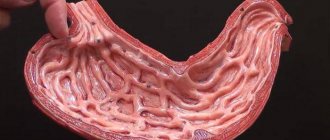Whipple's disease is a rare chronic multisystem pathology of infectious origin. Most often, general practitioners (therapists) and gastroenterologists encounter it, because the most common reason for an initial visit to a specialist is signs of damage to the joints and gastrointestinal tract.
Previously, Whipple's disease was fatal in 100% of cases, but currently it has a favorable prognosis. Adequately selected antibiotic treatment regimens can not only save patients’ lives, but also significantly improve its quality even at advanced stages of the disease.
Historical reference
Whipple's disease is a bacterial disease that is transmitted by the fecal-oral route.
Whipple's disease was identified as an independent pathology not so long ago; it is named after the name of the English pathologist George Hoit Whipple who first described it. In 1907, he published an article with a post-mortem pathological analysis of one clinical case at the John Hopkins Hospital.
D. Whipple discovered a complex of unusual changes in the organs of a 36-year-old patient who, for 5 years before his death, suffered from fever, enlarged lymph nodes, persistent cough, chronic diarrhea and progressive weight loss. He was found to have:
- signs of damage to all serous membranes (polyserositis);
- significant multiple enlargement of lymph nodes in the abdominal cavity;
- atypical deposition of lipids in the intestinal wall and lymphoid tissue;
- a significant increase in the number of macrophage cells and the appearance in them of foamy structures with argyrophilic rod-shaped inclusions.
Whipple called the identified disease intestinal lipodystrophy and suggested that it was infectious in nature. But the etiology of this pathology was reliably identified only in the second half of the 20th century, and after receiving positive results from antibiotic therapy.
Currently, according to ICD-10, Whipple's disease belongs to the class of diseases of the digestive organs and is coded by code K 90.8; if necessary, additional codes are also used to indicate developed extraintestinal manifestations. At the moment, just over 1,000 cases have been confirmed, and in total, about 2,000 observations of patients with symptoms of Whipple's disease have been described in the medical literature.
Etiology
Whipple described characteristic changes in the lymph nodes and intestinal wall and identified the disease as a separate nosological unit, but he could not unambiguously prove its bacterial etiology, although he pointed out the presence of microorganisms similar to spirochetes in the tissues of the small intestine. Whipple mistakenly believed that the cause of the disease was a disorder of lipid metabolism.
In 1949, a biopsy of the lymph nodes revealed so-called PAS-positive macrophages, inclusions in the foamy cytoplasm of which were similar to decay products of bacterial cells. The bacterial nature of the disease was also confirmed by the favorable results of massive antibacterial therapy. Several researchers have observed rod-shaped bacterial inclusions in macrophages, but have not been able to verify them.
The causative agent was identified much later, at the very end of the 20th century, using the polymerase chain reaction. It turned out to be a gram-positive bacterium related to one of the families of actinomycetes. It was named Tropheryma whipplei (T. whipplei or TW), which comes from the Greek. words trophe - nutrition, eryma - barrier.
Tropheryma whipplei has an oblong shape and a 3-layer cell wall, its size is approximately 0.2x2.0 µm (sometimes up to 3.0 µm). The small genome of this bacterium is located in a single circular chromosome, and its surface antigens are similar to human tissue antigens and therefore do not provoke a pronounced immune reaction. This is an important point in the pathogenesis of the disease.
2. Reasons
The period of scientific debate regarding the nature of Whipple's disease dragged on for many decades. For a long time, the metabolic hypothesis was dominant, according to which the disease is one of the variants of lipid (fat) metabolism disorders. However, traces of an immune reaction to an unknown pathogen were later confirmed (1949), and then, in 1991-1992, two independent researchers (R. Wilson, D. Rillman) using the polymerase chain reaction method identified a gram-positive actinobacterium, originally named - again , in honor of George Whipple, - Tropheryma whippelii. In 2001, this name, which is still used in the vast majority of domestic publications, was recognized as spelling incorrect and changed to Tropheryma whipplei.
Thus, Whipple's disease is an infectious disease. The pathogenic activity of the pathogen is found not only in the intestines, but also in many other organs and tissues, for example, in the lymphatic system, joints, etc.
It should be noted that the pathogenesis still remains not entirely clear. Researchers are paying attention to the sex ratio (see above), which is characteristic of many inherited diseases, and continue to search for genetic aberrations that may be responsible for the immune system "breakdown" in relation to Tropheryma whipplei.
Visit our Gastroenterology page
Epidemiology
Tropheryma whipplei is a ubiquitous bacterium, but the largest number of cases occur in North America and Central Europe. At the same time, only some strains are pathogenic for humans, and their entry into the body does not always lead to the development of the disease. Tropheryma whipplei is often isolated from the feces of absolutely healthy people.
The prevalence of Whipple disease is approximately 0.5–1 case per 1 million population. Currently, there are only about 1,000 officially recorded (and confirmed) episodes worldwide. 80% of the cases were men 40-50 years old. At the same time, it is assumed that there is a certain number of healthy carriers in the population, and many of them were most likely infected in childhood. But the normal “host-infection” immune reaction in their bodies does not give the pathogen the opportunity to actively reproduce and spread.
Whipple's disease: a "male" disease with a difficult diagnosis
Today I’ll tell you about a rare infectious disease in which 90% of patients are men. It affects the entire body, but it is difficult to diagnose. Whipple's disease is diagnosed on average only 5-6 years after the first symptoms appear. Without treatment, mortality approaches 100%.
There are 2,000 cases of Whipple's disease described worldwide, mostly in the white race. 80% of cases are men aged 40-50 years . Women rarely get sick (only 10% of all sick people). The disease was first described in 1907 by an American pathologist named George Whipple, who observed and then autopsied a patient with fever, joint pain, persistent cough, diarrhea and progressive weight loss.
The pathogen was isolated only in 1991. This is the bacterium Tropheryma whipplei (its modern name, the old one - Tropheryma whippelii). It reads [troferIma uIpple]. Tropheryma whipplei lives in naturally polluted environments and can be “caught” by swimming in lakes into which wastewater has been discharged. In natural habitats, bacteria contaminate 60-70% of soil and water samples. Farmers or people in contact with land and animals get sick more often. However, Whipple's disease develops only with certain disorders in cellular and humoral immunity, when the responsible cells of the immune system (macrophages) are not able to completely destroy (break down) the bacterium, which continues to multiply inside them. Bacteria accumulate inside macrophages as inclusions in the cytoplasm. Familial cases of Whipple's disease are known, but not a single case of transmission of the pathogen from person to person has been recorded.
The most curious thing is that, despite obvious deviations in the functioning of the immune system, the incidence of other infections does NOT exceed that among the rest of the population (with the exception of giardiasis). Most likely, the cause of Whipple's disease is rare mutations in a gene that affects the immune response.
The bacterium Tropheryma whipplei was found in 4% of patients with gastrointestinal pathology and in 1% of healthy people. The estimated incidence is 0.5-1 case per million population.
Infection occurs through the fecal-oral route. From the small intestine, the Tropheryma whipplei bacterium penetrates the mesenteric lymph nodes and the synovium of the joints. The circulation of lymphatic fluid in the body is disrupted. The bacterium subsequently spreads further throughout the body, affecting the heart, lungs, brain and eyes. Thus, Whipple's disease is a systemic disease (damage to several organs and systems of the body).
Symptoms of Whipple's disease
There are 3 phases of the disease.
THE FIRST PHASE lasts about 5 years. The patient is only concerned about fever (increased body temperature) and migrating pain in large and small joints (swelling is possible, but the joints are rarely deformed). Joint pain lasts from several hours to several days, then disappears completely and recurs at different intervals. The knee, wrist and ankle joints are most often affected. Rheumatoid factor is not detected (negative). If a patient receives immunosuppressive therapy for arthritis (corticosteroids, cytostatics and other immunosuppressive drugs), then the first phase of Whipple's disease is significantly shortened.
Lack of appetite and cough are less common.
Signs of Tropheryma whipplei infection:
- in 50% of patients there is an increase in lymph nodes throughout the body (lymph nodes are enlarged, mobile, painless),
- 45% have increased body temperature (chills followed by heavy sweating).
THE SECOND PHASE of Whipple's disease lasts 10-20 years, it is characterized by impaired absorption of nutrients in the intestines, constant loss of body weight and severe metabolic disorders (brittle nails, hair loss, night blindness, hyperpigmentation of the skin on exposed areas of the body and much more).
75% of patients experience diarrhea . In 40% of patients it happens up to 5-15 times a day. The stool is copious, light, foamy or ointment-like, foul-smelling. 50% have paroxysmal pain in the abdomen (usually in the navel area), usually after eating. Steatorrhea (oily, spotting stool) is often observed due to failure to digest fats.
Due to intestinal damage, malabsorption (poor absorption) develops, due to which almost all patients experience progressive weight loss, and there is also a deficiency of many vitamins, microelements and salts. Deficiency of vitamins and minerals further complicates and makes the clinical picture more varied. In 25%, 1-2 years after the onset of diarrhea, swelling (on the legs, in the abdominal or pleural cavity).
Only in rare cases of Whipple's disease can damage to internal organs (heart, brain, peripheral joints and spine, eyes) occur without clinical manifestations in the intestines.
THE THIRD PHASE lasts about 5 years and without treatment ends in death. Symptoms of the heart, respiratory system, central nervous system, etc. occur, and the patient dies from these complications and exhaustion.
Damage to other organs:
- in 50% of patients - a non-productive (dry) cough (without sputum production) due to compression of the trachea by the lymph nodes and chest pain;
- In 70% of patients, a few years after the onset of diarrhea, blood pressure drops below 110/60 mmHg. Art.;
- 40% have endocarditis (damage to the inner lining of the heart);
- eye damage (inflammation and impaired muscle tone). In 20% of patients with damage to the central nervous system (CNS), there are pendulum-like involuntary eye movements with synchronous contraction of the masticatory muscles (see video). Despite their rare occurrence, such movements are considered pathognomonic (specific) for Whipple's disease, i.e. Based on them, you can safely make a preliminary diagnosis.
Involuntary movements of the eyes and masticatory muscles are rare, but are considered specific to Whipple's disease.
Damage to the nervous system is the first manifestation of Whipple's disease in 10-15% of patients. Characteristic:
- 50% have mental disorders: depression, anxiety, psychosis;
- 50% have dementia (acquired dementia);
- 25% have seizures. There are also convulsive twitches of the masticatory and ocular muscles, which are considered specific to Whipple's disease;
- in 25% - damage to the cerebellum (cerebellar ataxia): instability in the Romberg position (standing with feet together, eyes closed and arms stretched straight out in front of you), and movement is uncertain, legs wide apart, while the patient is “thrown” from side to side. side;
- damage to the hypothalamus (thirst, increased appetite, decreased libido, lack of menstruation, insomnia, etc.).
Romberg pose
Cerebellar ataxia occurs in various diseases
Diagnosis of Whipple's disease
Whipple's disease can be suspected by joint pain and enlarged lymph nodes throughout the body for about 5 years, after which profuse diarrhea and progressive weight loss occur. If the first manifestation is damage to the central nervous system, making a diagnosis is even more difficult.
There is nothing special in the blood tests: increased ESR, leukocytes and platelets, low hemoglobin.
During FGDS (fibrogastroduodenoscopy), a biopsy of the mucous membrane of the small intestine is taken in several places and a PAS-reaction is performed on the biopsy to carbohydrates with glycolic groups (from the words periodic acid-Schiff). In Whipple's disease and some other diseases, the PAS reaction is positive: the tissue being examined turns red.
Using PCR (polymerase chain reaction), the DNA of the bacterium Tropheryma whipplei is detected. Determination of bacterial DNA in feces using PCR is becoming increasingly common, without the need to perform an FGDS. But the literature describes cases of Whipple's disease with a negative PCR result (the bacterium was not detected) and vice versa - positive PCR results in healthy people (because this bacterium is quite common in soil and water).
Antibody levels to Tropheryma whipplei antigens are not used because such antibodies are common in healthy individuals.
Prognosis of Whipple's disease without treatment:
- in 100% of cases the outcome is fatal,
- after the onset of joint pain, 80% will live 5 years,
- After the onset of diarrhea, only 20% will survive 5 years.
Treatment of Whipple's disease
Main principles of treatment :
- combating diarrhea and replenishing body weight and nutritional deficiencies;
- oral administration of biseptol (co-trimoxazole) 2 times a day for at least 1 year. If the patient has damage to the nervous system, then they start with a 2-week course of antibiotics (benzylpenicillin, ceftriaxone, meropenem, streptomycin, chloramphenicol to choose from), and then switch to biseptol.
With proper treatment:
- by the end of the first week, diarrhea disappears, body temperature normalizes;
- by the end of the first month, pain and swelling in the joints completely disappear, well-being significantly improves, and body weight increases. Disturbances in the nervous system are the slowest to normalize.
The effectiveness of treatment is usually monitored by PCR results of biopsies of the small intestinal mucosa for Tropheryma whippelii (must be negative). 30-40% experience relapses , including several months and even years after stopping treatment. In such cases, antibacterial treatment must be continued for another 1-2 years.
Pathogenesis. The role of immune disorders
Human infection occurs through the fecal-oral route. The pathogen does not require defects in the mucous membrane to penetrate the walls of the gastrointestinal tract. Most likely, the tissues of the small intestine become the entrance gate; this is where the most pronounced changes are noted. In this case, enterocytes (cells of the intestinal mucosa) are not primarily affected; the main disorders occur in the thickness of the tissues and in the regional mesenteric (mesenteric) lymph nodes.
Tropheryma whipplei requires special cells of the immune system - macrophages - to reproduce and spread. It is the disruption of their functioning that is the key point in the pathogenesis of Whipple's disease.
Normally, macrophages capture foreign cells entering the body, surrounding them with outgrowths and then, as it were, immersing them in their cytoplasm. This process resembles the feeding of an amoeba and is called phagocytosis. As a result, pathogenic microorganisms end up in a vesicle inside the cytoplasm of the macrophage, where they die and are broken down by enzymes. But with Tropheryma whipplei this protective mechanism does not work.
It is believed that the prerequisite for the development of Whipple's disease is certain immune disorders that are initially present in the infected person. This defect is very specific and does not lead to an increased risk of developing other infections. It is complemented by other immune disorders that occur after the introduction of T. whipplei.
- Macrophages in Whipple's disease retain the ability to phagocytose the pathogen, but they are unable to lyse (dissolve) them afterwards. Therefore, Tropheryma whipplei is able not only to remain viable in the cytoplasm of these immune cells, but also to actively reproduce. In fact, macrophages become a container and transporter for bacteria, creating conditions for their dissemination (diffuse spread) throughout the body.
- Changes in the ratio between the regulatory subpopulations of CD4 and CD8 T lymphocytes.
- A decrease in the ability of macrophages and some other immune cells to produce specific antibodies, which is explained by impaired recognition of Tropheryma whipplei surface antigens.
- Activation of the production of interleukin-16 (IL-16), which reduces the productivity of macrophage lysis and simultaneously promotes enhanced replication of the pathogen genome. The higher the concentration of this cytokine in the blood, the higher the disease activity.
All these immunological disorders contribute to the generalization of infection in Whipple's disease. Therefore, the symptoms are chronic, progressive and multisystem in nature.
Causes
The microbial etiology of Whipple's disease has now been confirmed, namely fungal. The manifestation and further progression of the disease are caused by the action and reproduction of gram-positive actinomycetes (in Latin Tropheryna whippelii).
This microbial organism is found on environmental objects, so it is almost impossible to avoid infection.
On the other hand, not every person into whose body this actinomycete has penetrated becomes ill with Whipple's disease.
Profound changes in the immune system are required, which are the basis for the damaging effects of the microbial factor. Factors that indicate a higher risk of developing Whipple's disease include:
- cases of autoimmune diseases among direct relatives;
- gene aberrations and chromosomal abnormalities;
- congenital or acquired immunodeficiency;
- male gender.
There may be certain genetic markers that indicate a high risk of developing Whipple's disease, but this information has not yet been confirmed.
The mechanism of development of the main symptoms
A mandatory sign of Whipple's disease is damage to the walls of the small intestine. They are infiltrated by multiple accumulations of large, malfunctioning macrophages, which significantly impairs lymphatic drainage from the intestinal villi and the process of fat absorption. As a result, malabsorption of all nutrients develops (panmalabsorption syndrome) with corresponding intestinal symptoms, and fatty inclusions begin to settle in the tissues. The affected areas of the intestine stretch and thicken, the villi in these areas shorten and thicken.
Macrophages that have absorbed bacteria migrate throughout the body, overcome tissue barriers and form fat-containing infiltrates in other organs. Settling on the serous membranes, they lead to the development of serositis and polyarthritis. Moreover, in some cases, such symptoms are relapsing-progressive in nature and precede typical intestinal manifestations of the disease.
At a certain stage of the disease, the affected macrophages penetrate the blood-brain barrier. The changes that occur in the brain include:
- Infiltration of brain tissue along vessels of various sizes. Multiple lesions of different sizes appear in both white and gray matter.
- The appearance of microglial nodules in the cortex and subcortical structures with astrocytosis in the periphery. The cells that form them contain PAS-positive inclusions (as in the cytoplasm of macrophages) or even the bacteria themselves.
- As the process increases, the neural network is involved in the process. There is demyelination of nerve processes, vacuolization of cells and the appearance of bacterial inclusions in their cytoplasm. The volume of brain tissue progressively decreases, and the productivity of the brain decreases.
It is also possible that microbleeds of various locations may appear, which aggravates neurological symptoms. This is explained by blockage of small vessels in the brain by emboli of cardiac (cardiogenic) origin.
Without treatment, pathological changes in Whipple's disease progress steadily and quite quickly; the patient's death occurs against the background of multiple critical brain disorders and multiple organ failure.
Clinical picture
At an early stage of the disease, a person develops pain in the joints, enlarged peripheral lymph nodes, and also develops symptoms of general intoxication.
The duration of the incubation period is currently not reliably known. Whipple's disease has 3 clinical stages:
- The initial phase, or the stage of nonspecific manifestations. It is characterized by damage to joints, peripheral lymph nodes, joints, skin, muscles, and general intoxication symptoms. Despite the inevitable damage to the walls of the digestive tract, Whipple's disease in the vast majority of cases debuts with extraintestinal manifestations. Symptoms appear and increase gradually, their presence is often attributed to banal infections or the patient’s chronic pathology.
- The advanced or abdominal stage, characterized primarily by the development of intestinal disorders. In this case, malabsorption with the development of malabsorption syndrome, abdominal pain, chronic diarrhea (usually of the steatorrhea type due to excess undigested fat in the feces), and flatulence are added to the existing symptoms. This leads to increasing hypovitaminosis and anemia, contributes to disturbances in water-mineral metabolism and generally depletes the patient.
- The stage of generalization of infection, with damage to many organs. The process usually involves the heart valves, endocardium, pleura, lung tissue, central nervous system (primarily the brain) and the membranes of the eyeballs. The appearance of fatty infiltrates and other localizations is possible. Symptoms become polymorphic and increasing. The condition is steadily worsening, and without adequate treatment, Whipple's disease leads to the death of the patient.
The overall duration of the disease varies. The total duration of stages 1 and 2 can reach 20–25 years. An unfavorable sign indicating a significant worsening and obvious progression of the disease is the addition of neurological symptoms. After their appearance, stage 3 is diagnosed; the duration of this stage without treatment usually does not exceed 5 years.
At the same time, sometimes neurological symptoms are detected even before characteristic intestinal disorders. This does not serve as an exclusion criterion for diagnosing Whipple's disease, but is regarded as a prognostically unfavorable sign.
3. Symptoms and diagnosis
Most authors distinguish three stages (phases) in the course of Whipple's disease: extraintestinal, intestinal and systemic. However, years may pass from the appearance of prodromal signs - dysfunction of one or another organ outside the gastrointestinal tract (kidneys, skin, eyes, etc.), weight loss, low blood pressure, joint inflammation, etc. - to classical intestinal symptoms, which makes diagnosis extremely difficult.
In typical cases, the intestinal, advanced stage of Whipple's disease is caused by malabsorption syndrome - impaired absorption and incomplete absorption of nutrients in the small intestine: chronic diarrhea, steatorrhea ("fatty" feces), weight loss, fever, hypovitaminosis and other associated symptoms.
At the third, multisystem stage, neurological, cardiovascular, polyserositic symptoms are added (in the absence of etiopathogenetic treatment, severe, progressive and ultimately fatal).
Diagnosis is based on a thorough study of the clinic and the dynamics of the condition, however, only a histological analysis of the biopsy sample (characteristic multiple fat deposits) is necessary and sufficient confirmation. Whipple's disease, especially if such suspicion arises in the early stages, should be clearly differentiated from rheumatoid arthritis, hypocorticism, etc.
About our clinic Chistye Prudy metro station Medintercom page!
Neurological manifestations of Whipple's disease
Neurological symptoms in Whipple's disease are quite polymorphic. Its nature and severity depend on the location and size of infiltrates and hemorrhages formed in the brain, and the severity of atrophic processes.
Neurological manifestations of Whipple's disease include:
- Increasing intellectual-mnestic (cognitive) decline, often reaching the level of dementia (dementia). The disorders are cortical-subcortical in nature and irreversible even after eliminating the infectious agent. Cognitive decline of varying severity develops over time in 50% of patients with Whipple's disease.
- Hyperkinetic syndrome, usually in the form of myoclonus. Most often, oculofascial myorhythmia develops - a combination of spontaneous pendulum-shaped converging (converging) nystagmus and rhythmic movements of the lower jaw, soft palate, lips, tongue, and eyelids. Such synchronous myoclonus of the eyeballs and facial muscles is considered by many doctors to be a symptom pathognomonic for Whipple's disease, although they are observed in approximately 20% of patients. Rhythmic hyperkinesis can also involve the muscles of the neck, various parts of the limbs, and the torso; in this case, they speak of the development of skeletal myorhythmia.
- Supranuclear ophthalmoplegia, diagnosed in approximately 40–50% of patients. It is characterized by limitation of voluntary movement of the eyeballs, paresis of vertical gaze is predominantly noted. In this case, there is no double vision (diplopia) and strabismus, and reflex combined movements are preserved. Ophthalmoplegia syndrome is associated with damage to the nerve structures that are responsible for the innervation of the extraocular muscles and are located above the nuclei of the corresponding cranial nerves.
- Convulsive syndrome with the development of generalized or partial epileptiform seizures.
- Hypothalamic disorders. Polydipsia (excessive water consumption), bulimia (uncontrolled eating of excessive amounts of food), various types of insomnia (sleep disorders), sexual disorders, and amenorrhea in women may occur. Clinical signs of damage to the hypothalamic region are observed in approximately 30% of cases.
- Cerebellar ataxia. Almost ¼ of patients with Whipple's disease have varying degrees of severity.
Less common are cortical visual impairment, hemiparesis, lower spastic paraparesis caused by myelopathy, and hypokinesia.
In a significant percentage of cases, mental disorders are also noted, and they can occur at different stages of Whipple's disease. Anxiety and depression, psychotic symptoms are possible.
Possible consequences and prognosis for life
Without the use of long-term antimicrobial therapy, Whipple's disease in a patient with severe clinical symptoms ended in death after 1-2 years. Currently, complex therapy allows one to achieve long-term remission for 8-10 years.
In continuation of the topic, be sure to read:
- Causes of bloating and increased gas formation, treatment methods
- Acute and chronic enteritis: causes, symptoms and treatment methods
- Rectal fissure: causes, symptoms and treatment of pathology
- More about hemorrhoids: causes, symptoms and treatment methods
- Irritable bowel syndrome: symptoms and treatments
- Rectal cancer: symptoms, stages, treatment and prognosis for life
- Details about bowel cancer: stages, symptoms, treatment and prognosis
- Malabsorption syndrome: definition and treatment recommendations (diet, medications)
- Diseases of the ileum: symptoms and signs of the disease, treatment
- Sigmoiditis (inflammation of the sigmoid colon): symptoms and treatment methods
Diagnostics
Half of people with Whipple's disease develop intellectual impairment, including dementia.
The main way to confirm Whipple's disease is to examine a biopsy of the small intestine. In this case, morphologically in the tissues the following are found:
- Infiltrates of the lamina propria of the intestinal mucosa, which are formed by PAS (or PAS)-positive large macrophages with foamy cytoplasm and coarse inclusions.
- Thickening, shortening and change in the shape of the villi of the intestinal mucosa. They become club-shaped, with excess lymph and fatty inclusions.
- Extra- and intracellular accumulation of fat in the mucous membrane of the small intestine.
- The presence of rod-shaped bacteria in the intercellular space and inside cells, which is detected mainly by electron microscopy of a biopsy specimen.
It is recommended to supplement the morphological study with the PCR method, which allows for reliable verification of the pathogen. For this, various biological materials can be used: biopsies of the intestine, kidneys, liver, lymph nodes, samples of cerebrospinal fluid and synovial fluid. PCR has high sensitivity and specificity, making it possible to diagnose the disease even with questionable and false-negative results of pathological examination.
All other research methods provide only indirect and nonspecific data. Therefore, general clinical and biochemical blood tests, coprogram, and instrumental methods of tissue visualization cannot act as a way to confirm or exclude Whipple's disease.
Treatment
Whipple's disease at any stage requires systemic antibacterial therapy; it was the beginning of the use of antimicrobial agents that at one time made it possible to reduce the lethality of this pathology. The prescribed antibiotics must have a bactericidal effect and penetrate well into all tissues, into the joint fluid and into the cerebrospinal fluid.
According to current clinical guidelines, treatment for Whipple's disease includes:
- The starting period (the first 2 weeks of therapy), during which preference is given to parenteral administration of antibacterial drugs. Ceftriaxone (2 g/day) or meropenem (3 g/day) or a combination of benzylpenicillin (12 million units/day) with streptomycin (1 g/day) can be used.
- Maintenance treatment (over the next year, sometimes up to 2 years). Most often, co-trimoxazole is used; if signs of resistance appear, the patient is transferred to a combination of doxycycline and hydroxychloroquine. And in the presence of neurological symptoms, the treatment regimen is supplemented with sulfadiazine up to 4 mg/day.
If necessary, symptomatic treatment is added to this etiotropic treatment. It can be aimed at correcting disorders of water-salt metabolism and deficiency of vitamins and basic nutrients, and mitigating existing symptoms. At the initial stages of treatment, a diet is necessary.







